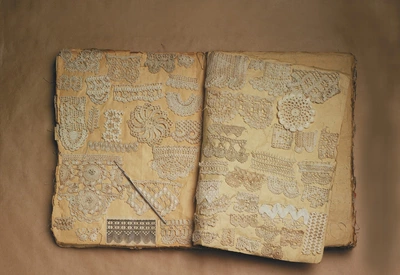History of Crochet and its Purpose
Once believe to be a historically European craft, researchers suggest other possibilities of origin are even older. Such as Egypt civilization & ancient China.
Old crochet pieces & proof of their past existence are hard to come by. Unfortunately, not a single piece of crochet fabric created before the 19th century has been saved.
But that doesn’t mean the isn’t any evidence, because I found a whole lot!
Crochet has a long history, with similar techniques being discovered in Israel as early as 6500 BC. Similar forms of this type of stitch can also be traced back to the Middle Ages when it was used for a wide variety of purposes such as clothing decoration, religious items, and military uniforms.
History Of Crochet Full Video
This article is pretty lengthy. If you want to skip the reading, watch the video instead! See more ancient crochet-related pictures & techniques.
6500 B.C. The oldest crochet stitch
Let’s start at the beginning with the oldest crochet stitch. The oldest form is the slip-stitch, but that’s the term we use today.
According to interweave.com, It was known as “shepherd’s knitting” in the British Isles and pjoining in Denmark. But we are looking at the grandmother of old stitching, nalbinding.
Nalbinding is much older than crochet or knitting. The oldest known piece dates back to 6500 BC. It was found in the Nahal Hemar Cave.
But Nalbinding differs from traditional crochet. According to Interweave, the creator makes a loop with thread or yarn and pulls another loop through it. This technique uses small lengths of string.
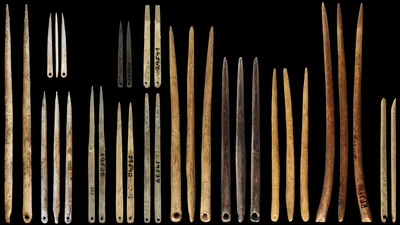
The tool used is a small hook with an eye, made of bone, wood, or animal horn. The hooks were flat, with sharp points and a widening handle.
Early evidence of Nalbinding was found in Tybrind Vig, a Mesolithic fishing village in Denmark dating back to 4200 BC. One of the rarest & oldest surviving pieces using this technique are these Egyptian socks, with a divided toe, from the 200 or 300 AD. These are held at the Victoria & Albert Museum in London.
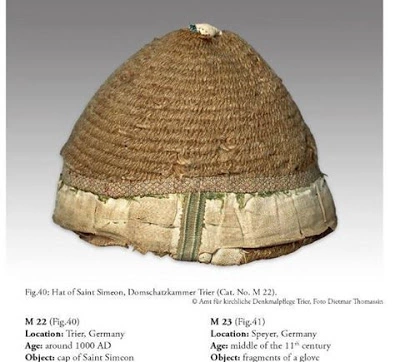
Not to leave out any countries, we know that there is evidence that slip-stitching was done by a hook in Scotland, Sweden, Norway, Iceland, Estonia, Romania, and the Balkans.
550 B.C. The evolution of the stitch
The Slip-stitch is an obvious descendant of nalbinding, Yet, slip-stitch crochet is not what we think of when we crochet today.
Modern-day crochet builds angles, patterns & decorative designs. To achieve that, crochet had to transform. It needed bigger stitches. What sparked these changes?
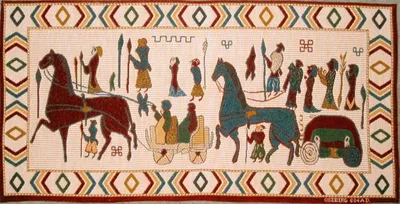
Tapestry crochet is a technique for painting imagery with stitches. This colorwork called for the development of a taller stitch. Instead of a stitch consisting of a single loop, a taller, square-shaped stitch—the single crochet stitch—was created.
The square grids assisted in the embroidery design. Tapestry crochet had a broad global reach and appeal. It developed in many places where slip-stitch crochet was done and then spread beyond those regions.
Historians theorize that this beautiful tapestry crochet possibly developed in Arabia, and it spread eastward to Tibet and westward to Spain, following the Arab trade routes and immigrating into other Mediterranean countries. These routes were used between 300 A.D. to 1453
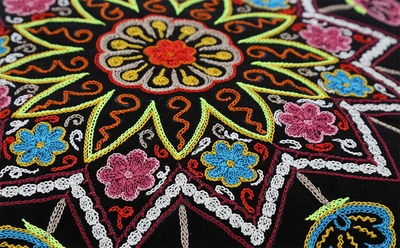
In these areas, Rashti Duz, which literally means, Rashti-style crochet, was a hugely popular fabric of the time. Popular doesn’t mean easier to make.
In Iran, Rashti Duzi is a form of traditional sewing and crocheting of Rasht. It is one of the most beautiful, intricate works of art, that’s rooted in their cultural background
Some historians believe Rashti Duzi the ancestor of crochet began between 550 -33 BC. Using a crafted hook and brightly colored silk yarn on a woven fabric
Textile exports from Iran in the 400 AD were popular all over Europe – so much so that European kings and elders would use them to cover the graves of iconic historical figures. The Hermitage Museum in Russia houses an exquisite piece of Sassanid fabric decorated with crocheting work.
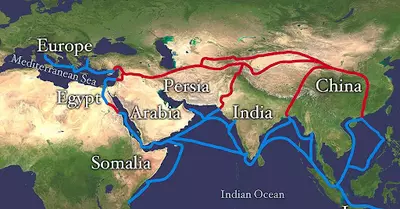
900 A.D. Egypt
Let’s look at some pictures that closer resembles crochet.
The photo below shows a ripple design that, at first look, resembles an old-fashioned crochet chevron afghan. The Benaki Museum in Athens, Greece houses this rare object which was initially mistaken for a popular crochet design.
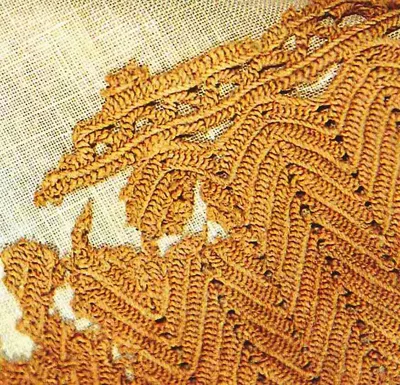
However, it does have the same pattern as that classic crochet pattern. Don’t be fooled, this piece of thread-work came from an Egyptian tomb. It was made between 900 and 1100 A.D.
But it’s called thread-work by the curators. These stitches look exactly like double crochet stitches! This ancient handmade piece uses advanced techniques to create a chevron pattern.
According to Talking Crochet, “Although this Egyptian sample lies mutely in a museum, it speaks to us across the generations. Most convincingly, the piece isn’t a simple or crude pattern of chain stitches alone — a technique thought to have been invented sometime during the 1600s. It is an advanced style, showing a definite pattern and skilled technique.”
The experts know some sort of tool would be required for something like this, due to the uniform intricate stitches. In my heart, I know a hook definitely made these stitches
Early Cultures Using Nalbinding
Examples of crochet early cousins, Nalbinding, were also found in Northern Europe in Viking territory between 800–1066 AD
Also, there is early evidence dating back to indigenous tribes in South America. Intricate needlework was used in a girl’s coming-of-age rite.
1500 Age Of Modern Crochet
Traces of crochet can also be found in Asia. One of the earliest types of crochet-ish dolls was found in China during the Shang Dynasty, dating back to the 16th century.
In China, it was an early example of 3D characters made from a kind of needlework. You may recognize the name, It was called amigurumi in Japan and became popular.
1600s Europe
After Developing in China, Turkey, India, Persia, and North Africa, it finally reached Europe in the 1600s and was referred to as “tambouring,” from the French “tambour” or drum. Which is embroidery made on a taunt stretch-out fabric.
American crochet expert and world traveler Annie Potter says, “The modem art of true crochet as we know it today was developed during the 1500s. It became known as ‘crochet lace’ in France and ‘chain lace’ in England.”
In Italy, it was called ‘nun’s work’ or ‘nun’s lace.’ As nuns first started to work on it, it was called church textiles. Apparently, they were able to create crochet stitches in order to represent religious icons, crosses, and more.
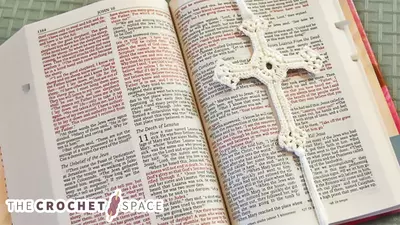
According to Crochet Guild Of America, At the end of the 18th century, tambour evolved into what the French called “crochet in the air,” when the background fabric was discarded and the stitch worked on its own.
1800s Irish Crochet
The earliest published crochet pattern was printed in 1823 by a Dutch magazine called Penélopé. *add more
Mademoiselle Riego de la Branchardiere is generally credited with the invention of Irish Crochet, publishing the first book of patterns in 1846.
Little did they know at the time who Irish crochet would aid in the Potato famine relief.
During the Potato Famine(1845-1850), poverty-stricken Irish men women & children would sell “Irish Crochet” to make ends meet. Teachers were even trained and sent across Ireland to teach this craft.

There is even a reference to someone during the great Irish famine using a stiff wire inserted into a piece of cork or tree bark. The end was filed down and bent into a little hook to produce some fine Irish crochet.
When the Irish immigrated to the Americas, they were able to take with them crocheting.
At the end of the 1800s, crochet was beginning to chain
1900s
In the US, Crochet laces were new and peaking between 1910 and 1920.
Crochet became even more elaborate in texture and complicated stitching. Early in the 1900s, new publications arose using crochet threads using brightly colored silk and elaborate beading.
After World War 2 into the early 1960s, the craft remained primarily as a homemakers’ art. Until the late 1960s and early 1970s when the new generation renewed interest in crochet, particularly in the United States & UK with many funky designs.
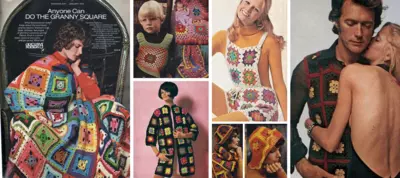
Granny squares become super popular around this time. You were able to find this easy pattern on everything from clothing, bags & decor. The granny square has yet to go out of style. I still see it on the runway or on celebrities, year after year.
1980s Crochet Popularity Decline
Fashion of the 1980s placed heavy emphasis on cheap clothes, fashion accessories, and very big poofy hair. The clothes were bright and loud. Fashion changed, as a reaction against THE “granny square loving hippie” movement of the past decades.
The 80s were full of the preppies, punks & B-boys, not a great breading ground for yarn crafts.
The popularity of crochet showed a sharp decline during this period in the Western world. Sales of patterns and yarns slumped, as the craft was increasingly seen as old-fashioned and children were rarely taught yarn crafts in school.
Not to mention that machine-knitted items were a lot cheaper and more available, WHICH made it a no-brainer purchase. They also came in unique designs (perfect for the 80s), which gives consumers access to quick, fast & cheap yarn-made items.
Crochet & knitwear lost popularity over the new fashions, such as spandex, ripped jeans & mullets. Micro-knit synthetic fabric is produced more cheaply and quickly. These fabrics could also easily be printed with fashionable designs. Although made from knit fabric, they are not considered knitwear.
These new trends, along with moving away from formality in clothing, Knitwear became associated with “Fancy casual” wear. Dressing up for everyday wear was unnecessary.
Like how I go to the store in my Pjs
1990s Crochet Magazines Decline
By the 1990s, many suppliers to the home crochet market ceased to produce or sell yarn, while local shops experienced a sharp decrease in numbers. Despite this, home crocheting still had a very strong and loyal following.
The 90s brought another fashion change & changing views toward the craft of crochet.
Fashion & Technology was changing at a fast pace. Yarn crafts were seen as old fashion and at its lowest popularity. The remaining support came from the crochet lovers of the 60s &70, books, magazines, and Craft Fairs for those wanting to share their skills with others.
But newer generations weren’t picking up on the craft. Why crochet, when you just got introduced to the World Wide Web!?!
But what was once thought to be the final nail in the coffin, actually was the boost that crochet needed to survive this new technological age.
The internet-enabled crocheters to share advice, patterns, and experience, but also it meant that home crocheters had direct access to supplies, not needing local yarn stores or books.
These trends have continued, to the detriment of small yarn shops. If you would like me to do a video on that topic, comment down below.
2000s
The 2000s brought with it a new online crochet community. Once a solo craft, it was now able to be shared with friends all across the world!
According to Allison Maynes’s study about the effects of loneliness & connections of female crocheters & knitters in Facebook groups. She states, “Regardless of geographical distance, or never [physically meeting members], the ties they develop become significant as they share their interest to knit or crochet, their images of finished items or frustrations at problems to solve”.
Tons of communities were showing up online at the time. Were you a member of any online yarn group in the early 2000s?
Yarn Bombing
Another unique practice starting to arise at this time, Yarn bombing. The practice is believed to have originated in the U.S.
The start of this movement has been attributed to Magda Sayeg, from Houston, who says she first got the idea in 2005 when she covered the door handle of her boutique with a custom-made cozy.
Since then yarn bombing’s popularity has spread throughout the world.
A well-known famous Crochet Yarn Bomber, London Kaye creates yarn bomb graffiti and, in addition to her art installations, creates advertisement yarn bombs for brands like Valentino and Miller Lite.
Kaye has received backlash for her installations when they are hung in public unauthorized, and one installation in Bushwick called “Moonshine Kingdom” was met with arguments, that “sprayed graffiti” is prosecuted as illicit, while trendy yarn graffiti is not criminalized.
Public outcry concerning the installation labeled this type of graffiti a symbol of gentrification, although an article by The New York Times claims a double standard in criticism of yarn bombing, and that women’s work is seen as “cutesy” and inherently less valuable.
Yarn bombing has been under MORE scrutiny for the potential negative environmental impact that the yarn can have when placed on plant life.
According to Odyssey, yarn can restrict sap production on trees and constrict growth. The knitted or crocheted material requires removal and cleaning up; if left behind, installations become soggy and synthetic fibers litter the environment.
What is your opinion on the subject?
The Disappearance of Crochet Magazines
Being such a niche industry, crochet magazine sales began to decline. Due to cheaper, and easier to access digital patterns instead of paper magazines. Crochet is a small portion of the already niche industry of fiber arts.
Most magazines are released every other month or quarterly. According to Feltmagnet.com, The fact that magazines today aren’t published as frequently reflects the need to limit production in the market to keep it affordable to print these magazines and to make sure that they don’t have to disappear off of the market as well!
Crochet books & magazines were once the heart of our crochet subculture. But it’s hard to connect with just a page. Online magazines not only offer patterns, but articles, videos, and more, they bring connection and enrichment to crocheters worldwide.
As the internet progressed, so did the craft of crochet. The internet allows a larger crochet community to form. We were able to share our interests and learn from each other, whether across the street or across the globe.
Patterns from both print and online sources have inspired groups (known as crochet-a-longs, or CALs) centered on crocheting a specific pattern. Crochet podcasts have also emerged, information-rich crochet blogs, and online magazines. Traditional designs and techniques, that had been preserved by a relatively small number of crocheters, are now finding a wider audience as well.
Lack of Diversity
You may have noticed, throughout the history of crochet, the lack of diversity in the craft. In the early 2010s before I ever started my own YouTube channel. It was rare to see a person of color. The few times I did it were the Double Crochet Twins, who worked with Red Heart at the time, & Twinkie Chan, both I think deserve their own video for being OG pioneers.
Yarn companies & Yarn magazine were the people in charge of creating & finding Crochet influencers & designers. 99% of the time, those designers were white. Leading to the false belief that crochet was solely a white craft.
If you wanted to crochet, you had no other option but to follow the pattern that was available to you.
But thanks to the internet, POC designers found a way to get their patterns seen.
Self-published pattern designers
During the 2010s Crochet blogs with free patterns, Etsy & Ravelry took off. Offering ways for self-published crochet designers to get their work into the world. With asking the MAN for permission!
The craft began to grow at a faster pace. Once it went to YouTube & became a moving visual medium, it changed forever.
A little YouTube fun fact, on July 23, 2006, one of the first crochet videos was uploaded to YouTube by Tripiano.
Some of the first English-speaking Crochet YouTubers were, The Crochet Crowd & Natazia. If you know any Early Crochet YouTube pioneers, please comment down below.
These early pioneers brought me back to crochet. I was able to watch it on my phone or find a cool free pattern on my computer.
I didn’t have to buy a crochet book or magazine. I chose the designers I liked & many other people around the world were doing the same. People became dedicated followers to Bag O Day Crochet or Jayda in Stitches. Thus began the Crochet Influencer.
I’m sure this was not their intention, and both of these women are the most modest women I know, but once you put a face to something, you have the potential to become a star.
(Name Crochet YouTube Stars)
2020s Current Crochet Trends
During the beginning of the Pandemic, the flood gate of new crocheters came pouring in. Whether to pass time, disconnect from a screen, or cope with anxiety, people started picking up hooking.
With use of social media, crocheters are able to showcase their love for the craft. Take a scroll through Instagram or TikTok to find Gen Zers making magic with yarn. Teens and 20-somethings document their creative process, from inspiration through to completion.
Affordability is a top priority, with many replicating garments that would otherwise be well out of their price range. Like Harry Style’s JW Anderson sweater that cost $1500!
Some content creators will actually teach you to make something, while others simply take you along for the cozy, satisfying ride.
Fashion Industry
The fashion industry is definitely taking notice. Your grandma’s favorite pastime is a major trend. Spotted on the Spring/Summer 2021 runways of major brands like Bottega Veneta, Fendi, and Dior, as you can see crochet isn’t going anywhere.
Tops, dresses, pants, swimwear, and even accessories like bags, hats, and shoes made with crochet.
Delsy Gouw, the founder of knitwear accessories label Memorial Day, turned her own crocheting hobby into a business after losing her job in the midst of COVID-19. Now, her hats and bikinis are seen on trendsetters like Kylie Jenner, Bella Hadid, and Ella Emhoff.
She says, “The way crochet is done is truly so intricate, unique, and is made to last,” Gouw told TZR in February about the technique. “Crochet can only be done by hand so I think there is something special about having an accessory that is unique and handmade.”
Learn more about Crochet machines here. I did a whole video about it.
Crochet & Fast Fashion
But that was Crochet High Fashion, let’s talk about the Low Down Dirty Fast Fashion.
Have you seen the crochet top everybody is talking about from Walmart? This piece has a lot of people pissed off & understandably so.
We feel as if big business is trying to profit off the work of the small designer. They see you online doing it big & want to cash in on it themselves. As a lone Sleuth, I tried to research where they are manufacturing these crochet items.
But first, you need to learn about Fairtrade.
Fairtrade brings products from poorer regions into more developed economies. A minimum price is agreed on to make sure that producers will be able to earn a living wage & have safe working conditions.
Walmart is currently Fair Trade Certified, so I can’t definitively say that these items were made in a sweatshop. And they claim to be moving in a more sustainable direction. But I’m not going to pretend like Walmart didn’t have a bloody past.
In 2012, a garment factory fire in Bangladesh killed at least 112 Another incident in 2013 Rana Plaza collapse caused over 1,000 garment workers to die on the job.
Since this incident, Walmart has cleaned up its ways. According to their website, they’re now offering Fair Trade Fashion called Free Assembly, which focuses on sustainable materials — though largely unmentioned companies.
Free Assembly’s relies on Fair Trade factories, at least in its denim line, is similar to what many “ethical fashion” brands used to assure customers that they’re not underpaying their workers.
Trust me, I tried to find them. If you know any information, please let me know down below.
A Huge problem surrounding Fair Trade organizations is that they often engage with companies that behave unethically. Fair Trade cannot guarantee that organizations will be able to sell all their “Fair Trade Certified products” under those agreed conditions, which include minimum pricing and premiums.
But if you want to learn more about crochet & fast fashion, you’re going to want to look at this article HERE.
Conclusion
Crochet has long been seen as an activity meant exclusively for mothers and stay-at-home wives and has often been associated with a homely look, but these misconceptions are being challenged currently.
I believe since the 60s & 70s, the soul of crochet has been put back into the craft again. Online magazines, YouTube, Social media & online communities lead to home-designed crochet items that reflect their personal style. Not just following a pattern a yarn manufacturer tells you to make.
More patterns are being sold by indie crochet designers on online platforms, and there are even more amazing crochet patterns on YouTube, such as my Channel.
Crochet doesn’t have to be a dying craft. The history of crochet needs to be preserved so that it can be carried on in the future. We should start digitizing crochet patterns and distributing them around the world so that more people learn about this art form.

If you enjoyed the history of crochet, find out how fast fashion companies use sweatshops to sell crochet.
Happy Crocheting!
Psst… If you love free crochet patterns (I know…duh) make sure to follow my blog on Facebook, Instagram, or Pinterest! Littlejohn’s Yarn posts original designs and free crochet pattern round-ups regularly for you to enjoy.


